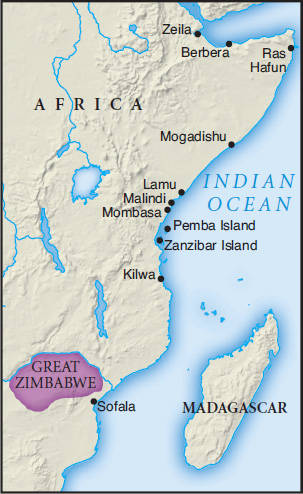Sea Roads as a Catalyst for Change: East Africa
Connection
Question
What was the role of Swahili civilization in the world of Indian Ocean commerce?
[Answer Question]
On the other side of the Indian Ocean, the transformative processes of long-distance trade were likewise at work, giving rise to an East African civilization known as Swahili. Emerging in the eighth century C.E., this civilization took shape as a set of commercial city-states stretching all along the East African coast, from present-day Somalia to Mozambique.
The earlier ancestors of the Swahili lived in small farming and fishing communities, spoke Bantu languages, and traded with the Arabian, Greek, and Roman merchants who occasionally visited the coast during the second-wave era. But what stimulated the growth of Swahili cities was the far more extensive commercial life of the western Indian Ocean following the rise of Islam. As in Southeast Asia, local people and aspiring rulers found opportunity for wealth and power in the growing demand for East African products associated with an expanding Indian Ocean commerce. Gold, ivory, quartz, leopard skins, and sometimes slaves acquired from interior societies, as well as iron and processed timber manufactured along the coast, found a ready market in Arabia, Persia, India, and beyond. At least one East Africa giraffe found its way to Bengal in northeastern India, and from there was sent on to China. In response to such commercial opportunities, an African merchant class developed, villages turned into sizable towns, and clan chiefs became kings. A new civilization was in the making.

Between 1000 and 1500, that civilization flourished along the coast, and it was a very different kind of society than the farming and pastoral cultures of the East African interior. It was thoroughly urban, centered in cities of 15,000 to 18,000 people, such as Lamu, Mombasa, Kilwa, Sofala, and many others. Like the city-states of ancient Greece, each Swahili city was politically independent, generally governed by its own king, and in sharp competition with other cities. No imperial system or larger territorial states unified the world of Swahili civilization. Nor did any of them control a critical choke point of trade, as Srivijaya did for the Straits of Malacca. Swahili cities were commercial centers that accumulated goods from the interior and exchanged them for the products of distant civilizations, such as Chinese porcelain and silk, Persian rugs, and Indian cottons. While the transoceanic journeys occurred largely in Arab vessels, Swahili craft navigated the coastal waterways, concentrating goods for shipment abroad. Swahili cities were class-stratified societies with sharp distinctions between a mercantile elite and commoners.
Culturally as well as economically, Swahili civilization participated in the larger Indian Ocean world. Arab, Indian, and Persian merchants were welcome visitors, and some settled permanently. Many ruling families of Swahili cities claimed Arab or Persian origins as a way of bolstering their prestige, even while they dined from Chinese porcelain and dressed in Indian cottons. The Swahili language, widely spoken in East Africa today, was grammatically an African tongue within the larger Bantu family of languages, but it was written in Arabic script and contained a number of Arabic loan words. A small bronze lion found in the Swahili city of Shanga and dating to about 1100 illustrates the distinctly cosmopolitan character of Swahili culture. It depicted a clearly African lion, but it was created in a distinctly Indian artistic style and was made from melted-down Chinese copper coins.19
Furthermore, Swahili civilization rapidly became Islamic. Introduced by Arab traders, Islam was voluntarily and widely adopted within the Swahili world. Like Buddhism in Southeast Asia, Islam linked Swahili cities to the larger Indian Ocean world, and these East African cities were soon dotted with substantial mosques. When Ibn Battuta (IH-buhn ba-TOO-tuh), a widely traveled Arab scholar, merchant, and public official, visited the Swahili coast in the early fourteenth century, he found altogether Muslim societies in which religious leaders often spoke Arabic, and all were eager to welcome a learned Islamic visitor. But these were African Muslims, not colonies of transplanted Arabs. “The rulers, scholars, officials, and big merchants as well as the port workers, farmers, craftsmen, and slaves, were dark-skinned people speaking African tongues in everyday life.”20
SUMMING UP SO FAR
Question
To what extent did the Silk Roads and the Sea Roads operate in a similar fashion? How did they differ?
[Answer Question]
Islam sharply divided the Swahili cities from their African neighbors to the west, for neither the new religion nor Swahili culture penetrated much beyond the coast until the nineteenth century. Economically, however, the coastal cities acted as intermediaries between the interior producers of valued goods and the Arab merchants who carried them to distant markets. Particularly in the southern reaches of the Swahili world, this relationship extended the impact of Indian Ocean trade well into the African interior. Hundreds of miles inland, between the Zambezi and Limpopo rivers, lay rich sources of gold, much in demand on the Swahili coast. The emergence of a powerful state, known as Great Zimbabwe, seems clearly connected to the growing trade in gold to the coast as well as to the wealth embodied in its large herds of cattle. At its peak between 1250 and 1350, Great Zimbabwe had the resources and the labor power to construct huge stone enclosures entirely without mortar, with walls sixteen feet thick and thirty-two feet tall. “[It] must have been an astonishing sight,” writes a recent historian, “for the subordinate chiefs and kings who would have come there to seek favors at court.”21 Here in the interior of southeastern Africa lay yet another example of the reach and transforming power of Indian Ocean commerce.